 It’s summer in Tucson and a host of University of Arizona Health Sciences programs designed to foster diversity in the health professions run from June through August with a similar goal: to address related disparities for underserved communities.
It’s summer in Tucson and a host of University of Arizona Health Sciences programs designed to foster diversity in the health professions run from June through August with a similar goal: to address related disparities for underserved communities.
Among these are the BLAISER (Border Latino & American Indian Summer Exposure to Research) Program, and the Focusing Research on the Border Area (FRONTERA) Summer Internship Program.
FRONTERA
The goal of the FRONTERA program (June 3-Aug. 5) is to prepare students that are interested in addressing health disparities in the U.S.-Mexico border region to become a more competitive med school applicant. The 10-week program offers an MCAT boot camp and also a 6-week prep course, besides the opportunity to work on a research project with a renowned faculty mentor from the UA.
 “We have 11 interns this summer, all interested in pursuing a career in medicine,” said Alejandra Zapien Hidalgo, MD, an assistant professor in the Department of Family and Community Medicine, director of the UA College of Medicine – Tucson’s Bilingual Medical Spanish and Distinction Track, and FRONTERA coordinator. See below for a list of students with their mentors.
“We have 11 interns this summer, all interested in pursuing a career in medicine,” said Alejandra Zapien Hidalgo, MD, an assistant professor in the Department of Family and Community Medicine, director of the UA College of Medicine – Tucson’s Bilingual Medical Spanish and Distinction Track, and FRONTERA coordinator. See below for a list of students with their mentors.
“This week we volunteered at the Benedictine Monastery (in Tucson, where Catholic Social Services’ Casas Alitas Program is hosting a shelter for detainees released by U.S. Immigration and Customs Enforcement, ICE, until transportation can be arranged to where their asylum sponsor is located and before an immigration hearing can be scheduled),” she added.
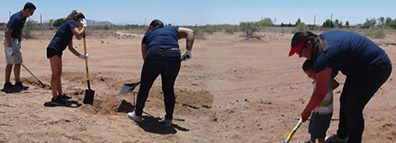 “Next week, we will be traveling to the border. We will work in the community center in Winchester Heights community in Wilcox, Ariz., Sells, Ariz., and Nogales, Mexico. The goal of this trip is for the students to see firsthand what they have learned in classes about health disparities and the current situation in the border region.”
“Next week, we will be traveling to the border. We will work in the community center in Winchester Heights community in Wilcox, Ariz., Sells, Ariz., and Nogales, Mexico. The goal of this trip is for the students to see firsthand what they have learned in classes about health disparities and the current situation in the border region.”
This year’s participants and their mentors include:
- STUDENT: Dina Albayati — Marlon Guerrero, MD, associate professor of surgery and otolaryngology and vice chair of quality and performance, UA Department of Surgery
- STUDENT: Carlos Banda — Marvin Slepian, MD, professor of cardiology, biomedical engineering, materials science and medical imaging; director, Arizona Center for Accelerated Biomedical Innovation (ACABI); and member, UA BIO5 Institute and Sarver Heart Center
- STUDENT: Ana Maria Driesen — Lilah Morrison-Wiseman, MD, assistant professor of surgery and associate program director, General Surgery Residency Program and ACES Advanced GI/MIS Clinical Fellowship
- STUDENT: Bianca Duarte — Khadijah Breathett, MD, assistant professor of medicine and member, UA Sarver Heart Center, heart failure specialist with the Advanced Heart Failure, Mechanical Circulatory Support and Cardiac Transplantation Team at Banner – University Medical Center Tucson
- STUDENT: Gissel Heraldez — Khiem Tran, PhD (third-year med student who received a 2018 American Skin Association Grant Targeting Melanoma and Skin Cancer)/Mindy Fain, MD, (shadowing) professor of medicine and nursing; chief, Division of Geriatrics, General Internal and Palliative Medicine; co-director, UA Center on Aging; and the Anne and Alden Hart Endowed Chair in Medicine
- STUDENT: Annette Kahecmi — Martha Monroy, rural programs manager at the Arizona State Office of Rural Health, UA College of Public Health
- STUDENT: Michele Nadler — Amanda Arrington, MD, assistant professor and community outreach associate director, Department of Surgery
- STUDENT: Omar Puebla — Elaine Situ-LaCasse, MD, assistant professor, Department of Emergency Medicine
- STUDENT: Ryan Silva — Valentine Nfonsam, MD, associate professor and, director, General Surgery Residency Program, UA Department of Surgery
- STUDENT: Ycied Talavera — Jessica Moreno, MD, assistant professor, Department of Obstetrics and Gynecology
- STUDENT: James Winslow — Michael Grandner, PhD, assistant professor, Department of Psychiatry, and director, Sleep and Health Research Program
BLAISER
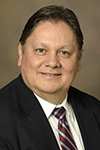 BLAISER kicked off June 4 with an address by program director Jorge Gomez, MD, PhD. Dr. Gomez also is an assistant professor of pharmacology and public health, assistant director of cancer research at the UA Cancer Center, associate director of the UA Health Sciences Center for the Elimination of Border Disparities, co-director of Clinical Translational Sciences, and assistant vice president of Translational Research in Special Populations. He offered an overview of the program, which includes a lecture series, for its 20 participants from across the country.
BLAISER kicked off June 4 with an address by program director Jorge Gomez, MD, PhD. Dr. Gomez also is an assistant professor of pharmacology and public health, assistant director of cancer research at the UA Cancer Center, associate director of the UA Health Sciences Center for the Elimination of Border Disparities, co-director of Clinical Translational Sciences, and assistant vice president of Translational Research in Special Populations. He offered an overview of the program, which includes a lecture series, for its 20 participants from across the country.
Previously under the UAHS Office of Diversity and Inclusion, the BLAISER Program is now administered through the UAHS Office of the Senior Vice President, led by Michael D. Dake, MD.
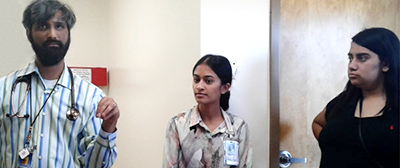 “This year the BLAISER program is thriving!” Dr. Gomez said. “We received close to 116 applications and were able to accept 20 students. No question that the program is becoming very competitive and better known in particular in the Southwest. Most of our students are from Arizona, including from border towns like Nogales, Douglas, and Yuma, but they also come from California and as far away as Virginia.”
“This year the BLAISER program is thriving!” Dr. Gomez said. “We received close to 116 applications and were able to accept 20 students. No question that the program is becoming very competitive and better known in particular in the Southwest. Most of our students are from Arizona, including from border towns like Nogales, Douglas, and Yuma, but they also come from California and as far away as Virginia.”
Most students who apply are Hispanics, but the program continues to attract a diverse group of Native Americans as well. The majority are juniors/seniors, although under exceptional circumstances advanced sophomore and recent graduates are accepted.
“We believe BLAISER is making a difference in guiding students at a critical path of their careers when they need close advice and guidance to prepare them for the next critical steps: making a decision of applying to a professional career, or applying for other areas like research in health sciences. Regardless of their choice, BLAISER continues to emphasize the importance of working with disadvantage communities either as health professionals or researchers, which is badly needed in Arizona,” Dr. Gomez added.
EXTRA INFO: BLAISER/FRONTERA Community Outreach
For news on how the programs interact in underserved communities, see the following from the Southeast Arizona Area Health Education Center, which is among five regional centers statewide affiliated with the Arizona Area Health Education Centers Program coordinated through UAHS:
“BLAISER Students Conduct Influenza Outreach” | (Southeast Arizona Area Health Education Center – SEAHEC) Posted June 2018
“FRONTERA Students Community Collaboration Addresses Public Health Disparities” | June 2018
“SEAHEC’s “Fight the Bite!” Work Cited in New ADHS Report” | (SEAHEC) Posted September 2017
“BLAISER Students Return to Help ‘Fight the Bite’” | (SEAHEC) Posted July 2017
“Frontera Students Conduct Health Education in Ambos Nogales” | (SEAHEC) Posted June 2017
“FRONTERA Helps us Fight the Bite” | (SEAHEC) Posed July 2016
“UA BLAISER Students Join “Fight the Bite” Campaign” | (SEAHEC) Posted June 2016
Following is the BLAISER lecture schedule along with links to where you can view video (all lectures are in Drachman Hall Room A114):
- “Minority and Border Health Disparities Lecture Series: Introduction & Overview” — Dr. Jorge Gomez | June 4, from 9-10 a.m. | no video link
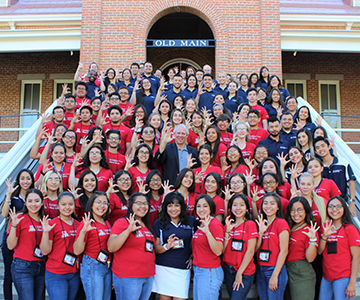
- “Building Healthy Communities in the Arizona-Sonora Border Region: Today’s Strengths and Challenges” — Jill Guernsey de Zapien | June 5, 10-11 a.m. | https://tinyurl.com/MBHDLS-Jill-G-De-Zapien
- “Can We Design a New, Non-Opioid Pain Drug?” — Rajesh Khanna, PhD | June 18, 9-10 a.m. | https://tinyurl.com/MBHDLS-Rajesh-Khanna
- “Addressing Cancer Health Disparities” — Heidi Hamann, PhD | June 18, 1-2 p.m. | https://tinyurl.com/MBHDLA-Heidi-Hamann
- “The Significance of Indigenous Data Sovereignty and Governance (for Scientists, Researchers, and Community Health and Wellbeing)” — Stephanie Carroll Rainie, DrPH, MPH | July 2, 10-11 a.m. | https://tinyurl.com/MBHDLS-Stephanie-Rainie
- “The Privilege of Serving a Border Community” — Eladio Pereira, MD, internist, Mariposa Community Health Center, Nogales, Ariz. | July 15, 10-11 a.m. | https://tinyurl.com/MBHDLS-Eladio-Pereira
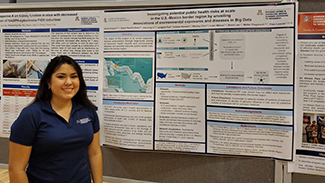
- “Clinical Research Disparities” — Anna Teresa Valencia, MPH | July 19, 10-11 a.m. | https://tinyurl.com/MBHDLS-Anna-Valencia
- “Substance Misuse in Pima County” — Francisco A.R. Garcia, MD, MPH | July 22, 9-10 a.m. | https://tinyurl.com/MBHDLS-Francisco-Garcia
- “Title: Pending” — Agnes Attakai | July 23, 9-10 a.m. | no video link
- “Mental Health Along the US-Mexico Border” — Francisco Moreno, MD | Aug. 2, 9-10 a.m. | https://tinyurl.com/MBHDLS-Francisco-Moreno
ALSO SEE:
“Students Spend Transformative Summer on the U.S.-Mexico Border” | (UA News) Posted July 29, 2019
“Future Physicians, Researchers Spend Transformative Summer on the U.S.-Mexico Border” | Posted July 17, 2019
“Summer Institute on Medical Ignorance Cultivates Student Curiosity” | Posted July 16, 2019
“Med-Start: 50 Years Helping Young People Prepare for Their Future in the Health Professions” | Posted July 12, 2019
“BLAISER Lectures, Program Aim at Orienting Students toward Careers in Biomedical Research” | Posted June 15, 2018
“Designed to Increase Diversity in Health Care, UA Health Sciences’ Summer Programs Commence June 5” | Posted June 2, 2017

